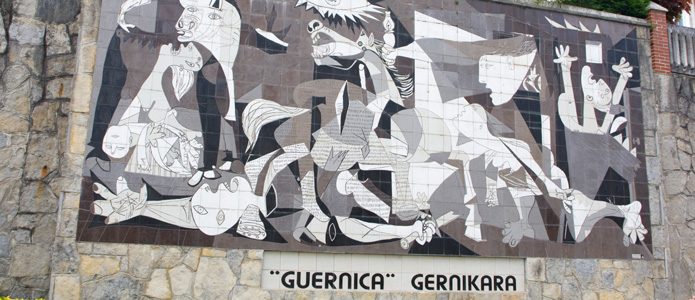In 1937 the German Luftwaffe destroyed the Spanish city of Guernica. Rotterdam, Warsaw and Coventry were to follow. That these cities are today closely associated with Germany is also an achievement of civil society.
It was under the impression of shock at the violence and destruction that Pablo Picasso created in 1937 probably the most famous anti-war picture of the twentieth century: Guernica. The widow of the former American Vice President Nelson A. Rockefeller donated to the United Nations a reproduction of this work in the form of a tapestry. It hung in the antechamber of the Security Council Assembly Room until 2009.
In February 2003, when the then American Secretary of State Colin Powell explained to the world press why the United States had to wage war against Saddam Hussein, the copy of the famous painting was covered up to be on the safe side. The necessary war fever would have rapidly cooled if the cameras had panned not only the heads of the warlords but also the consequences of war: mutilated bodies, weeping women, calamity and destruction.
With his painting, Picasso commemorated the annihilation of the Basque city of Guernica in April 1937 by a heavy attack of the German Air Force. Subsequently, the Luftwaffe also bombed Warsaw, Coventry and Belgrade; Rotterdam and London were also attacked. Joseph Goebbels, the Nazi propaganda minister, invented the verb “coventrieren” (to conventry) for these bombings, and meant thereby not merely the eradication of whole cities but also the annihilation of the civilian population.
Complete destruction
In Guernica, there were several hundred dead; three and half years later, in Conventry, England, 569 people perished during the attack codenamed “Moonlight Sonata”. The medieval St. Michael’s Cathedral, together with the historic old town, was almost completely destroyed. Its ruins have been preserved as a warning against a new war.
As early as 1947, a Friends of Coventry Society was formed in Kiel, which had been largely destroyed by Great Britain’s Royal Air Force. The then mayor of the city Andreas Gayk sent a message with the request for reconciliation: “If we speak in future of ‘conventrying’, then this should mean the cultivation of friendly relations between our countries, the surmounting of national passions for the benefit of the common tasks of all European peoples.”
This was not so easy, as the 1958 state visit to England of the then Federal President Theodor Heuss showed. He travelled to Coventry and donated 60,000 marks for rebuilding the cathedral. The historian A.J.P. Taylor wrote in the
Sunday Express: “We cannot become friendly with the Germans before the generation that served Hitler has died out.” And in an interview with
Spiegel, William Connor, who wrote for the
Daily Mirror under the pseudonym “Cassandra”, said he wished that Germany stayed “locked up in a refrigerator for fifty years”.
Engaged civil society
That things turned out differently owed perhaps less to official gestures than to the commitment of individuals. Parallel to the Federal Republic’s integration into the West, city partnerships were established, youth exchanges were agreed upon and mutual visits of associations and professional groups took place. Almost entirely on his own, the then Hamburg Senate spokesman Erich Lüth sought reconciliation with Jews who had fled Germany and found refuge in the newly founded state of Israel. In 1951 he published an article entitled:
We Appeal to Israel for Peace.
In her dissertation
Die versöhnten Bürger: Der Zweite Weltkrieg in deutsch-niederländischen Begegnungen 1945-2000 (2014) (i.e. “Reconciled Citizens: The Second World War in German-Dutch Encounters, 1945-2000”), the historian Christine Gundermann shows, using the example of the city partnership between Rotterdam and Duisburg, that international understanding does not always need the pedagogical zeal of the authorities or, as in Kiel, the desire for reconciliation of the mayor: both harbour cities not only had a similar economic structure, but in Duisburg there had also existed for a long time a large Dutch community.
Interest in peace
As early as 1949, at a meeting of the Foundation for Harbour Affairs (Stichting Havenbelangen), the Rotterdam mayor Gerard van Walsum expressly greeted the German “friends from Duisburg”. Although in 1966, when the Dutch princess Beatrix married the German diplomat Claus von Amsberg, there were considerable protests against this kind of official conciliation with the Germans, mutual economic interests had already helped much earlier to push the past into the background.
At “Harbour Day”, which was observed in Duisburg a half year after the 1949 meeting in Rotterdam, it was already possible to agree, for example, that economic interests should be looked upon as more important than political ones. While “what the Netherlands had to endure during the war is well-known”, said the then Duisburg mayor August Seeling, he appealed to the “sensible people” who sought to “remove, stone for stone, the obstacles in the path to a peaceful cooperation for the benefit of the two countries”.
Seeling even called for drawing a “veil over the past”. His colleague van Walsum, who had visited Duisburg in 1954, thanked the city for the donation it had made to restoring the destroyed St. Lawrence Church in Rotterdam and accepted the offer of reconciliation. Thus, it was not primarily politics, but rather the civil population, whose sufferings in war Picasso had so impressively portrayed in his work, that ensured peace after the devastations of the Second World War.
